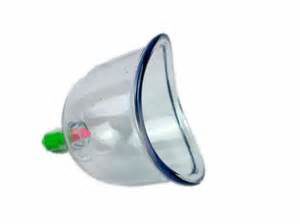Negative pressure is a potential novel technique that can be used to manipulate height growth but there is nothing in the evidence to suggest that it will increase height growth. The main selling point behind it is that it’s novel and is inversely related to the concept of LSJL(which wants to increase pressure). The inverse relation may actually eventually prove useful as you could do rapid sunctioning and unsunctioning to build pressure or you could cup every area other than the epiphyseal region of the bone(But the blood just seems to rise to the area of sunction not to other areas).
Here’s a cupping device:
Cupping essentially manipulates fluid and blood flow. So is there a way to use such a cupping device on the bone or maybe the cartilage?
The device is not expensive:
Rather than cupping the back, you would cup the synovial joints or epiphyseal region if this had any potential to work. The bruising redness often seen with cupping is reported to be caused by a discharge of blood from the vessels but can this be used to induce height growth.
First, this would have to manipulate the blood within the bone itself and it’s possible that it does because blood vessels are interconnected but in addition it would have to manipulate blood flow to increase hydrostatic pressure in the epiphyseal region. You would either have to put the cup on the target area or everywhere but the target area. If cupping makes the blood flow it has to go somewhere and unfortunately it seems to head into the red spots seen post cupping.
One thing that could be done is to rapidly cup and uncup a region creating a pressure gradient.
I think cups like this with might work better for that:
According to this cupping website, cupping can activate the secretion of synovial fluids but I’m not sure that can cause height growth unless their are nutrients in the synovial fluid that can stimulate endochondral chondrogenesis.
Cupping is basically the inverse LSJL. LSJL involves lateral tissue compression whereas cupping is negative pressure.
According to Effect of Negative Pressure on Human Bone Marrow Mesenchymal Stem Cells In Vitro:
“The aim of this study was to determine how low-intensity intermittent negative pressure affects the differentiation and proliferation of human mesenchymal stem cells (MSCs), as well of OPG and OPGL mRNA expression in MSCs. MSCs were isolated from adult marrow using the density gradient separation method, passaged for three generations, and divided into the vacuum group, which was administrated at pressure of −50 kPa{So LSJL involves positive pressure and this involves negative pressure}, for 30 min at a frequency of 2/d, and a control group. The differentiation of MSCs was examined through inverted phase contrast microscopy, measurement of alkaline phosphatase activity, alizarin-red staining, and immunohistochemistry for type I collagen, hypoxia-inducible factor-1α (HIF-1a), and vascular endothelial growth factor (VEGF). The MTT assay and flow cytometry were used to measure proliferation and apoptosis. Real-time PCR detected the expression of mRNA from OPG/OPGL. Compared to the control group, there was a decrease in the proliferation of cells in the vacuum group. The number of cells in S phase was reduced by 62.4%, while the rate of apoptosis, the activity of ALP, and calcium release all increased under vacuum conditions. Calcium nodes could be observed through alizarin-red staining, and the expression of collagen type I, VEGF, and HIF-1a were increased significantly. Expression of OPG mRNA was increased and the expression of OPGL mRNA decreased in the vacuum group relative to the control group. In conclusion, low-intensity intermittent negative pressure can inhibit the proliferation of human MSCs, induce differentiation to bone cells, promote the OPG mRNA expression, and reduce OPGL mRNA expression.”
This sounds like something unhelpful for height growth unless you make MSCs undergo a chondrogenic versus an osteogenic lineage but you never know.

